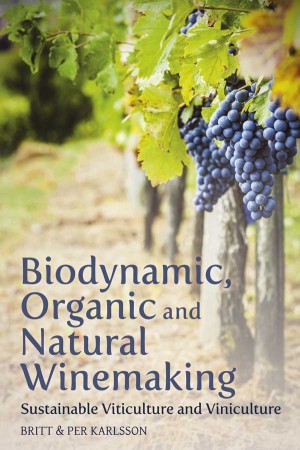To give you a bit more of an impression of what you will find in the book Biodynamic, organic and natural winemaking. Sustainable viticulture and viniculture here is the table of contents:
-

Biodynamic, organic and natural winemaking. Sustainable viticulture and viniculture. 1. Organic wine-growing – an overview
- Is the wine any different?
- Locally grown and small-scale
- Mind your language!
- Respect for the environment
- 2. Farming today
- The four main groups
- Conventional farming
- Organic farming
- Sustainable farming
- Biodynamic farming
- Common objectives
- 3. History in brief
- Crisis in the vineyard
- The post-war years
- Awareness
- Organic wine-growing
- 4. How widespread is organic wine-growing?
- Spain and Italy top the list
- France
- Austria and Germany
- The new world
- 5. Who goes organic?
- And why?
- The environment matters most
- Are organic wines more expensive?
- 6. Organic wine-growing
- How does organic differ from conventional?
- Good soil
- Roots matter
- What does the vine need?
- Weeds and cover crops
- The comeback of the hedge
- 7. Pests and diseases
- Fungal diseases
- Other pests
- 8. Pest control by natural means
- Préparations naturelles peu préoccupantes (PNPP)
- The nettle war
- Approval of organic plant protection products
- Copper and its alternatives
- Spraying
- Crosses and hybrids
- Genetically modified grape vines
- 9. I want to go organic ‒ how is it done?
- Official labelling
- The whole EU procedure
- The USA
- Switzerland
- Non-certification
- 10. Biodynamic wine production
- The practical side
- The preparations
- 500 – cow dung in cow horn
- 501 – quartz in cow horn
- 508 – horsetail
- The dynamiser and dynamisation
- The compost
- Compost turns biodynamic
- Preparations 502‒507
- Cosmic rhythm, the moon and the four kinds of days
- The consultants
- Control and rules
- Wine-growers and the practical results of biodynamics
- The practical side
- 11. Private labelling and control
- Private organic labels and organisations (a selection)
- International
- France
- Austria
- Switzerland
- Italy
- Germany
- California
- Australia
- South Africa
- Chile
- Argentina
- New Zealand
- Biodynamic certification labels
- Private organic labels and organisations (a selection)
- 12. The work inside the cellar
- Why have rules in the cellar?
- Why add sulphur anyway?
- Reduce by how much?
- The disadvantage of reducing sulphur content
- What is typical?
- Organic and authentic?
- 13. Additives
- Are additives and interference needed?
- Allergenic additives
- Which additives are used, and why?
- Additives and process during vinification
- Other matters
- 14. Sustainable wine-growing
- The definition of sustainable
- How do sustainable wine growers do things?
- Sustainability by the Cousinié method
- Labelling
- France
- Austria
- California
- Chile
- South Africa
- New Zealand
- Australia
- Fairtrade
- Code of conduct for Nordic monopolies
- 15. Vins nature – natural wines
- French natural
- Italian natural
- The taste
- 16. The environmental big picture
- Carbon dioxide emissions
- Wine transport
- Bulk shipping instead
- Carbon-neutral wines
- Lighter bottles
- Natural cork
- Solar collector panels
- Irrigation
- Trapping carbon dioxide
- Appendix 1: Recommended “natural wine” producers
- Appendix 2: A selection of favourite organic and biodynamic producers
More information
- Introduction to the book and overview
- Contents
- A selection of photography from Biodynamic, Organic and Natural Winemaking; Sustainable Viticulture and Viniculture.
- Excerpt from the introduction (to come)
- What people say, press clippings, news and web clippings
- Buy the book







